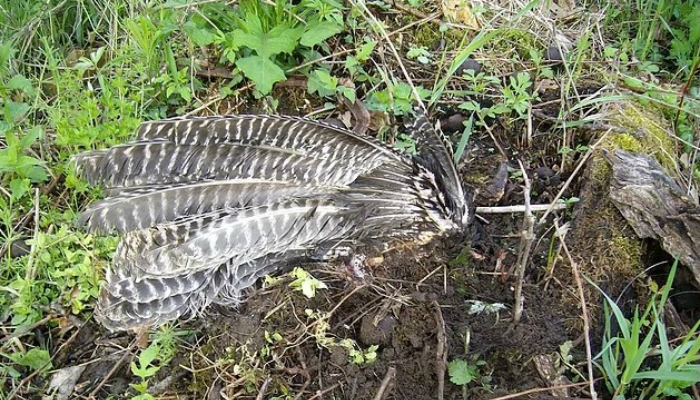Who Done It?

The thick, muggy air is stifling, but the sound of cold running water brings soothing thoughts of an oasis as I inch along a wooded stream corridor. I’m looking for the invasive species garlic mustard, honeysuckle, Japanese hedge parsley and poison hemlock hidden among the thick carpet of native spring flora. “What the heck is this?” I ask myself. “It looks like bird wing emerging from the ground.” I move closer, and realize it’s an Eastern wild turkey wing sticking up in the air with the rest of the turkey apparently buried in the soil below. Clearly, this turkey did not make a nose-dive crash landing. No, this is the work of a predator. But what predator? Who done it?
Spring nesting season brings immense danger for the hen turkey, not to mention her eggs and chicks. Typically, turkeys roost in trees at night, avoiding most predators. In the spring, however, the hen must incubate her eggs on the ground, greatly increasing the chance of predation on her and her eggs and chicks. Hen turkeys seek out thick areas to nest, and prairies provide ideal nesting habitat. Routinely, I’ll find four to six turkey nests in a 25-acre prairie. Along with the hen turkeys comes the predators, and many of these nests don’t make it. I’ll find scattered broken turkey eggs, feathers, and bone fragments littering the prairies every spring.
I tug gently on the wing, and it gives a little. Okay, I think, there is only a portion of the turkey’s body buried in the soil below. Also, the part of the turkey under the soil is indeed buried rather than just scraped over with loose surface soil debris. Given this is an adult hen turkey, I think we can rule out egg and chick predators such as opossums, skunks, mink, weasels and raccoons. Because this kill was buried, I also think we can rule out a large aerial predator such as a bald eagle.
Was it a badger? Badgers can dig like nobody’s business. They can also kill an adult turkey easily. However, they typically take the brute force approach to catching their quarry and dig it out of the ground. I don’t see the badger having the stealthy finesse needed to stalk a wild turkey. While badgers are not abundant on the landscape, they do frequent the property where the turkey kill was located.
Was it a bobcat? A true ambush predator that can easily kill an adult turkey, there is no doubt a bobcat has the skills to stalk and kill a paranoid turkey. However, they are not common, and I have not found any sign of them visiting this property. Also, cats tend to scrape loose surface soil debris to cover up kills rather than actually burying them below ground.
Was it a long-shot predator such as a mountain lion, wolf or black bear? While there are many reports, and some actual confirmations, of these animals visiting southern Wisconsin, the chances of one of these rare and infrequent predators making the turkey kill is remote.
Was it a red or gray fox? While I have not seen a gray fox in decades, red fox are occasionally observed in the area. They have the stalking skills and can easily kill an adult turkey. They are also known to bury prey.
Was it a coyote? Much more common on the local landscape than foxes, coyotes can stalk, kill and bury a turkey. In fact, I have witnessed coyotes target adult turkeys.
There are, of course, many other possibilities. It could have been a combo of predators. One species killed it while another scavenged and buried it. Or maybe the turkey just died of old age and the neighbor’s dog decided to bury a turkey bone?
Given the evidence on hand and my experience with the property, however, my money is on the coyote.
Originally published in Environmental Returns.
Tags: David Cordray, predator-prey

